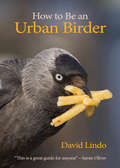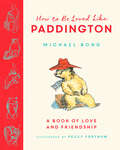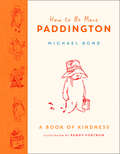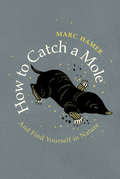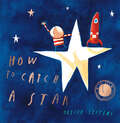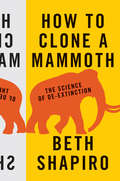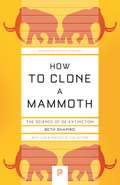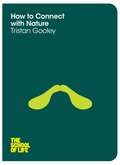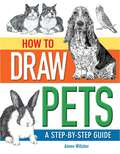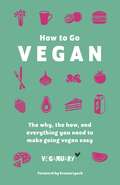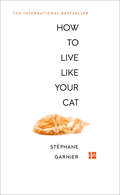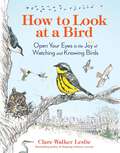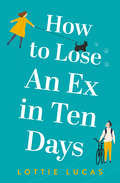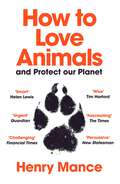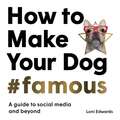- Table View
- List View
How to Be an Urban Birder (WILDGuides #13)
by David Lindo Jamie OliverThe first guide to urban birding in the UK, from The Urban Birder himself, David LindoUrban birding is fast becoming ornithology’s new rock ’n’ roll. Birds and birding have never been cooler—and urban birding is at the cutting edge.How to Be an Urban Birder is the world’s first guide to the art of urban birding—which is so easy and great fun! Here, urban birding pioneer David Lindo tells you everything you need to know about birds and birding in towns and cities in the UK.Includes a brief history of urban birding in the UKCovers the best places to look for birds in towns and citiesHelps you get to know your urban birdsGives useful tips on how to attract birds to your gardenExplains what gear you need and how to go about being an urban birderFeatures hundreds of cool images and illustrations of birds in urban settings
How to Be an Urban Birder (WILDGuides #13)
by Jamie Oliver David LindoThe first guide to urban birding in the UK, from The Urban Birder himself, David LindoUrban birding is fast becoming ornithology’s new rock ’n’ roll. Birds and birding have never been cooler—and urban birding is at the cutting edge.How to Be an Urban Birder is the world’s first guide to the art of urban birding—which is so easy and great fun! Here, urban birding pioneer David Lindo tells you everything you need to know about birds and birding in towns and cities in the UK.Includes a brief history of urban birding in the UKCovers the best places to look for birds in towns and citiesHelps you get to know your urban birdsGives useful tips on how to attract birds to your gardenExplains what gear you need and how to go about being an urban birderFeatures hundreds of cool images and illustrations of birds in urban settings
How to be Loved Like Paddington
by Michael BondA book of love and friendship – the perfect gift for Paddington Bear fans!
How to Be More Paddington: A Book of Kindness
by Michael BondLearn valuable life lessons from Paddington Bear himself in this inspirational book of kindness. The perfect gift for fans of the bear from Darkest Peru, who is now a major movie star!
How to Be Your Dog's Best Friend: A Training Manual for Dog Owners
by Monks of New SketeFor more than a quarter century, How to Be Your Dog's Best Friend has been the standard against which all other dog-training books have been measured. This expanded edition preserves the best features of the original classic while bringing the book fully up-to-date. The result: the ultimate training manual for a new generation of dog owners--and, of course, for their canine best friends. The Monks of New Skete have achieved international renown as breeders of German shepherds and as outstanding trainers of dogs of all breeds. Their unique approach to canine training, developed and refined over four decades, is based on the philosophy that "understanding is the key to communication, compassion, and communion" with your dog. How to Be Your Dog's Best Friend covers virtually every aspect of living with and caring for your dog, including: Selecting a dog (what breed? male? female? puppy or older dog?) to fit your lifestyle Where to get--and where not to get--a dog Reading a pedigree Training your dog or puppy--when, where, and how The proper use of praise and discipline Feeding, grooming, and ensuring your dog's physical fitness Recognizing and correcting canine behavioral problems The particular challenges of raising a dog where you live - in the city, country, or suburb The proper techniques for complete care of your pet at every stage of his or her lifeIn its scope, its clarity, and its authority, How to Be Your Dog's Best Friend remains unrivaled as a basic training guide for dog owners. Like no other book, this guide can help you understand and appreciate your dog's nature as well as his or her distinct personality--and in so doing, it can significantly enrich the life you share with your dog.
How to Build a Puppy: Into a Healthy Adult Dog
by Julia RobertsonDogs do not demonstrate discomfort or pain in a way that can be easily translated by us humans, so we often miss that they are physically struggling. Understanding that making some very simple changes to our homes, activities, exercise regimes and how we train our puppies will have a massive positive impact on our dogs' lives. Using her world-renowned Galen Myotherapy knowledge and approach, Robertson suggests and explains in detail how small, profoundly important but easy to implement changes can improve the way we not only look after and develop our puppies but also how maintenance of this easy programme continues your puppy’s journey through into healthy adolescence and maturity. Environment, exercise and activity habits have deep, ongoing effects and How to Build a Puppy ... into a healthy adult dog explores ways in which positive change can be integrated easily into our normal lives. The book culminates into a full programme called the Galen Myotherapy Puppy Physical Development Programme©. Including: A dedicated section on anatomy, explaining in a functional way how everything in the body interrelates to form a functional moving structure Practical advice that is made logical and easy to interpret by the use of clear comparative descriptions as well as clear diagrams and pictures showing the movement and biomechanics of dogs Exercises and activities in a practical programme, for all situations, that can be followed to help build good foundations A full pictorial explanation of why so many 'traditional' exercise routines and activities are in fact incredibly damaging for our dogs This book will help canine professionals better advise their clients, but also empower all readers to make their own changes, as well as having a better all-round understanding to enable more pertinent questions from their vet, breeder or puppy trainer.
How to Build a Puppy: Into a Healthy Adult Dog
by Julia RobertsonDogs do not demonstrate discomfort or pain in a way that can be easily translated by us humans, so we often miss that they are physically struggling. Understanding that making some very simple changes to our homes, activities, exercise regimes and how we train our puppies will have a massive positive impact on our dogs' lives. Using her world-renowned Galen Myotherapy knowledge and approach, Robertson suggests and explains in detail how small, profoundly important but easy to implement changes can improve the way we not only look after and develop our puppies but also how maintenance of this easy programme continues your puppy’s journey through into healthy adolescence and maturity. Environment, exercise and activity habits have deep, ongoing effects and How to Build a Puppy ... into a healthy adult dog explores ways in which positive change can be integrated easily into our normal lives. The book culminates into a full programme called the Galen Myotherapy Puppy Physical Development Programme©. Including: A dedicated section on anatomy, explaining in a functional way how everything in the body interrelates to form a functional moving structure Practical advice that is made logical and easy to interpret by the use of clear comparative descriptions as well as clear diagrams and pictures showing the movement and biomechanics of dogs Exercises and activities in a practical programme, for all situations, that can be followed to help build good foundations A full pictorial explanation of why so many 'traditional' exercise routines and activities are in fact incredibly damaging for our dogs This book will help canine professionals better advise their clients, but also empower all readers to make their own changes, as well as having a better all-round understanding to enable more pertinent questions from their vet, breeder or puppy trainer.
How to Build Animal Housing: 60 Plans for Coops, Hutches, Barns, Sheds, Pens, Nestboxes, Feeders, Stanchions, and Much More
by Carol EkariusWith dozens of adaptable plans for sheds, coops, hutches, multipurpose barns, windbreaks, and shade structures, this guide covers everything you need to know to build safe and sturdy housing for your animals. Stressing the importance of evaluating your goals, planning ahead, and budgeting accordingly, Carol Ekarius helps you determine the best structure for your particular situation and offers expert advice on tools and construction techniques. Build a functional and comfortable house for your animals that they&’ll be proud to call home.
How to Catch a Mole: And Find Yourself in Nature
by Marc HamerA life-affirming book about the British countryside, the cycle of nature, solitude and contentment, through the prism of a brilliant new nature writer’s experience working as a traditional mole-catcher, and why he gave it up.I have been catching moles in gardens and farms for years and I have decided that I am not going to do it any more. Molecatching is a traditional skill that has given me a good life but I am old now and tired of hunting and it has taught me what I needed to learn. Although common, moles are mysterious: their habits are inscrutable, they are anatomically bizarre, and they live completely alone. Marc Hamer has come closer to them than most, both through his long working life out in the Welsh countryside, and his experiences of rural homelessness as a boy, sleeping in hedgerows. Over the years, Marc has learned a great deal about these small, velvet creatures who live in the dark beneath us, and the myths that surround them, and his work has also led him to a wise and uplifting acceptance of the inevitable changes that we all face. In this beautiful and meditative book, Marc tells his story and explores what moles, and a life in nature, can tell us about our own humanity and our search for contentment.How to Catch a Mole is a gem of nature writing, beautifully illustrated by Joe McLaren, which celebrates living peacefully and finding wonder in the world around us.'From the first few words I knew I had encountered loving honesty and no one needs more than that. It is rare to encounter such respect and understanding of nature for herself.' Rosamund Young, author of The Secret Life of Cows
How to Catch a Star (Read aloud by Paul McGann)
by null Oliver JeffersThis is a read-along edition with audio synced to the text, performed by Paul McGann. An inspirational story of a boy who loved the stars so much, he decided to catch one of his very own. The beautifully illustrated, original debut picture book from shining talent Oliver Jeffers. There once was a boy who loved stars so much that he wished he had one of his very own. Every night he watched the stars in the sky from his bedroom window and dreamed of how he could be their friend and how they could play hide-and-go-seek together. So, one day, he decided to set about catching a star of his very own…
How to Clone a Mammoth: The Science of De-Extinction
by Beth ShapiroCould extinct species, like mammoths and passenger pigeons, be brought back to life? The science says yes. In How to Clone a Mammoth, Beth Shapiro, evolutionary biologist and pioneer in "ancient DNA" research, walks readers through the astonishing and controversial process of de-extinction. From deciding which species should be restored, to sequencing their genomes, to anticipating how revived populations might be overseen in the wild, Shapiro vividly explores the extraordinary cutting-edge science that is being used--today--to resurrect the past. Journeying to far-flung Siberian locales in search of ice age bones and delving into her own research--as well as those of fellow experts such as Svante Paabo, George Church, and Craig Venter--Shapiro considers de-extinction's practical benefits and ethical challenges. Would de-extinction change the way we live? Is this really cloning? What are the costs and risks? And what is the ultimate goal? Using DNA collected from remains as a genetic blueprint, scientists aim to engineer extinct traits--traits that evolved by natural selection over thousands of years--into living organisms. But rather than viewing de-extinction as a way to restore one particular species, Shapiro argues that the overarching goal should be the revitalization and stabilization of contemporary ecosystems. For example, elephants with genes modified to express mammoth traits could expand into the Arctic, re-establishing lost productivity to the tundra ecosystem. Looking at the very real and compelling science behind an idea once seen as science fiction, How to Clone a Mammoth demonstrates how de-extinction will redefine conservation's future.
How to Clone a Mammoth: The Science of De-Extinction
by Beth ShapiroCould extinct species, like mammoths and passenger pigeons, be brought back to life? The science says yes. In How to Clone a Mammoth, Beth Shapiro, evolutionary biologist and pioneer in "ancient DNA" research, walks readers through the astonishing and controversial process of de-extinction. From deciding which species should be restored, to sequencing their genomes, to anticipating how revived populations might be overseen in the wild, Shapiro vividly explores the extraordinary cutting-edge science that is being used--today--to resurrect the past. Journeying to far-flung Siberian locales in search of ice age bones and delving into her own research--as well as those of fellow experts such as Svante Paabo, George Church, and Craig Venter--Shapiro considers de-extinction's practical benefits and ethical challenges. Would de-extinction change the way we live? Is this really cloning? What are the costs and risks? And what is the ultimate goal? Using DNA collected from remains as a genetic blueprint, scientists aim to engineer extinct traits--traits that evolved by natural selection over thousands of years--into living organisms. But rather than viewing de-extinction as a way to restore one particular species, Shapiro argues that the overarching goal should be the revitalization and stabilization of contemporary ecosystems. For example, elephants with genes modified to express mammoth traits could expand into the Arctic, re-establishing lost productivity to the tundra ecosystem. Looking at the very real and compelling science behind an idea once seen as science fiction, How to Clone a Mammoth demonstrates how de-extinction will redefine conservation's future.
How to Clone a Mammoth: The Science of De-Extinction (Princeton Science Library #108)
by Beth ShapiroAn insider's view on bringing extinct species back to lifeCould extinct species, like mammoths and passenger pigeons, be brought back to life? In How to Clone a Mammoth, Beth Shapiro, an evolutionary biologist and pioneer in ancient DNA research, addresses this intriguing question by walking readers through the astonishing and controversial process of de-extinction. From deciding which species should be restored to anticipating how revived populations might be overseen in the wild, Shapiro vividly explores the extraordinary cutting-edge science that is being used to resurrect the past. Considering de-extinction's practical benefits and ethical challenges, Shapiro argues that the overarching goal should be the revitalization and stabilization of contemporary ecosystems. Looking at the very real and compelling science behind an idea once seen as science fiction, How to Clone a Mammoth demonstrates how de-extinction will redefine conservation's future.
How to Clone a Mammoth: The Science of De-Extinction (Princeton Science Library #108)
by Beth ShapiroAn insider's view on bringing extinct species back to lifeCould extinct species, like mammoths and passenger pigeons, be brought back to life? In How to Clone a Mammoth, Beth Shapiro, an evolutionary biologist and pioneer in ancient DNA research, addresses this intriguing question by walking readers through the astonishing and controversial process of de-extinction. From deciding which species should be restored to anticipating how revived populations might be overseen in the wild, Shapiro vividly explores the extraordinary cutting-edge science that is being used to resurrect the past. Considering de-extinction's practical benefits and ethical challenges, Shapiro argues that the overarching goal should be the revitalization and stabilization of contemporary ecosystems. Looking at the very real and compelling science behind an idea once seen as science fiction, How to Clone a Mammoth demonstrates how de-extinction will redefine conservation's future.
How to Connect with Nature (The School of Life #2)
by Tristan Gooley The School of LifeA deep knowledge of our natural environment is no longer a vital part of everyday survival, certainly for those of us living in cities and working in weatherproof offices. Unless we have an inherent love of the great outdoors, do we really need to connect with nature? Bestselling author Tristan Gooley believes that real connection, no matter how small, can enrich us as individuals, allowing us to see every living thing in its own intricate network. Offering a host of techniques, he helps us awaken our senses and deepen our understanding of nature's cycles, conflicts and relationships. By cultivating the right mindset we can gain a better appreciation of the world, both indoors and outdoors. One in the new series of books from The School of Life, launched January 2014: How to Age by Anne Karpf How to Develop Emotional Health by Oliver James How to Be Alone by Sara Maitland How to Deal with Adversity by Christopher Hamilton How to Think About Exercise by Damon Young How to Connect with Nature by Tristan Gooley
How to Crochet Animals: 25 Mini Menagerie Patterns
by Kerry LordHave fun at the farm with this new collection of minis from Kerry Lord and her Edward’s Menagerie animals. This is one of the new gift series from TOFT (Kerry’s yarn company), which contains four books, each with 25 crochet patterns on a different theme: Ocean, Wild, Farm and Pets.
How To Draw Pets: A Step-by-Step Guide
by Aimee WillsherPets are the most endearing of subjects. Capture the fuzzy feathers of a ducking or a cat stalking their prey in this beautifully illustrated, user-friendly manual. Award-winning artist Aimee Willsher shows you how to capture the essence of the animals you love using a range of drawing media. Including:• More than 20 step-by-step projects• Exercises showing how to master the primary shapes of popular pets• Tutorials on drawing your pet from life and from photographs• Demonstrations of a range of compositionsWhether you're a complete novice or want to take your pet portraits to the next level, How to Draw Pets will provide a firm grounding from which you can gain the confidence to develop your own style.
How To Go Vegan: The why, the how, and everything you need to make going vegan easy
by VeganuaryGoing vegan is easy!Whether you're already a full-time vegan, considering making the switch or know someone who is, this book will give you all the tools you need to make the change towards a healthier, happier and more ethical lifestyle. How to Go Vegan includes...Why try vegan?Animal welfare, the environment, health benefits and your personal adventure.Vegan at homeSurprisingly vegan foods, reading labels, vegan ingredient essentials, easy replacements, how to be the only vegan in the familyVegan out in the worldEating out, eating at friends' houses, answering questions from loved ones, travelling veganLiving the vegan lifestyleMeal plans, tips and tricks, what to do if you're struggling, how to celebrate being a veganHow to go vegan. It's easier than you think.
How To Keep Dinosaurs
by Robert MashHollywood and the popular press would have us believe that all dinosaurs are gigantic, hostile and untameable. In fact, there are many species that make charming and even useful companions: Velociraptor - a splendid, loyal, fierce, friendDeinonychus - will not eat dog food (dogs are another matter)Tyrannosaurus - least suitable to keep; will need special licenceOrnithomimus - an appealing first dinosaur for the child anxious for her first rideThis book advises you which dinosaur is right for you and your home, from the city apartment dweller looking for a lap pet, to the country estate owner looking to tighten up on security. HOW TO KEEP DINOSAURS is a bestselling guide, packed with the sort of information keen dinosaur keepers crave - from feeding and housing to curing common ailments, breeding and showing your animal. The author, a zoologist with extensive experience of dinosaurs, has provided a timely and much-needed source book for all those who keep dinosaurs and for the huge numbers who are contemplating getting one. It is as essential to every dinosaur keeper as a stout shovel and a tranquilliser rifle.
How to Live Like Your Cat
by Stéphane GarnierA fun present for cat lovers everywhere: a light-hearted self-help guide to help you live more like your cat
How to Look After your Dinosaur
by Jason CockroftWhat would you do if a dinosaur turned up on your doorstep? Well, that's exactly what happens to the little boy in this brilliantly illustrated, witty picture book. He must learn exactly how to look after his dinosaur: what to feed it for breakfast, where to take it for walks and, most importantly of all, how exactly to deal with its dinosaur-sized poo! A brilliantly funny story for toddlers from Jason Cockcroft, illustrator of 'Amazing Animal Journeys'.
How to Look at a Bird: Open Your Eyes to the Joy of Watching and Knowing Birds
by Clare Walker LeslieBestselling author and acclaimed nature illustrator Clare Walker Leslie invites beginning birdwatchers to hone their observational skills with this easy-to-use visual guide. Using her signature nature journal illustrations, Leslie shows readers the key clues to look for, from the shape of the beak or talons to distinctive feather colorings, flight patterns, and behavioral traits. She offers simple prompts that encourage readers to embrace curiosity and take a closer look: Where are you? What season is it? How is that bird moving or eating? With an emphasis on the birds that are most likely to be seen at a feeder, in a city park, or at a nature preserve, How to Look at a Bird makes bird watching, identification, and appreciation accessible to everyone, no matter where they live. This publication conforms to the EPUB Accessibility specification at WCAG 2.0 Level AA.
How to Lose an Ex in Ten Days
by Lottie LucasFor a fresh twist on How to Lose An Ex in Ten Days! This funny, warm-hearted romantic comedy is perfect for fans of Sophie Kinsella and Lindsey Kelk!
How to Love Animals: In a Human-Shaped World
by Henry ManceA far-reaching, urgent, and thoroughly engaging exploration of our relationship with animals - from the acclaimed Financial Times journalist.*A GUARDIAN 'BOOKS OF 2021' PICK* We all love animals, but does that make their lives happier? With factory farms, climate change and deforestation, this might be the worst time in history to be an animal. In an age of extinction and pandemics, our relationship with the other species on our planet has become unsustainable. What if we took animals' experiences seriously - how would we eat, think and live differently? Henry Mance sets out on a personal quest to see if there is a fairer way to live alongside other species. He goes to work in an abattoir and on a farm to investigate the reality of eating meat and dairy. He explores our dilemmas around hunting wild animals, over-fishing the seas, visiting zoos, saving wild spaces and owning pets. He meets the chefs, farmers, activists, philosophers, scientists and tech visionaries who are redefining how we think about animals. This is not a book about what animals can do for us, but what we can do for animals.
How To Make Your Dog #Famous: A Guide to Social Media and Beyond
by Loni EdwardsYou know your dog is the cutest but does everyone else know it too?In this book, Loni Edwards, the human behind the world's most influential pets, breaks down the path to fame. Discover insights into the success of social media's top pups and follow the essential steps on the road to fame - from crafting your brand to advocating for your pup on set. With expert guidance on how to be a good dog parent and make sure your pup is happy and healthy every step of the way, this is your one-stop guide to helping your dog win over hearts, one adorable post at a time.Featuring the stories of more than 40 of the most successful pet influencers:157 of Gemma, Amazing Graciedoodle, Barkley Sir Charles, Bertie Bert the Pom, Bronson the Bully, Brussels Sprout, Bully Baloo, Charlie the Black Shepherd, Chloe the Mini Frenchie (& Emma Bear), Coco the Maltese Dog (Coco & Cici), Cookie Malibu, Crusoe the Celebrity Dachshund, Daily Dougie, Dog named Stella, Ducky the Yorkie, Frame the Weim, Gone to the Snow Dogs, Harlow and Sage, Hi Wiley, Kelly Bove, Lilybug, Lizzie Bear, Louboutina the Hugging Dog, Maya Polar Bear, Mervin the Chihuahua, Milo and Noah, MJ the Beagle, Mr. Biggie, Popeye the Foodie, Puggy Smalls, Reagandoodle, Remix the Dog, Rocco Roni, Super Corgi Jojo, Super Scooty, Tatum, That Goldendoodle, The Bike Dog, Tika the Iggy, Tuna Melts my Heart, Tupey the Borzoi, Verpinscht, Winnie the Cocker, Wolfgang 2242
